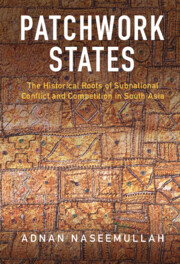Refine search
Actions for selected content:
33 results
Chapter 5 - Riots
-
- Book:
- Performing Justice in the Later Roman Empire
- Published online:
- 07 August 2025
- Print publication:
- 21 August 2025, pp 82-97
-
- Chapter
- Export citation
22 - Kristallnacht
-
-
- Book:
- The Cambridge History of the Holocaust
- Published online:
- 16 May 2025
- Print publication:
- 12 June 2025, pp 461-483
-
- Chapter
- Export citation
5 - “Man, in His Natural State … Must Either Be Led by Conviction, or by Force”
-
- Book:
- The Overseer State
- Published online:
- 21 March 2025
- Print publication:
- 27 March 2025, pp 184-236
-
- Chapter
- Export citation
7 - States of Emergency after Domestic Turmoil
-
- Book:
- State of Emergency
- Published online:
- 01 November 2024
- Print publication:
- 04 July 2024, pp 190-211
-
- Chapter
- Export citation
Chapter 2 - ‘An Infectious Madness’
-
-
- Book:
- Nineteenth-Century Literature in Transition: The 1830s
- Published online:
- 30 May 2024
- Print publication:
- 06 June 2024, pp 38-61
-
- Chapter
- Export citation
5 - The Murder Act: Anatomization, 1752–1832
-
- Book:
- Execution, State and Society in England, 1660–1900
- Published online:
- 12 October 2023
- Print publication:
- 26 October 2023, pp 141-196
-
- Chapter
- Export citation
Conceptualizing Nativism in Authoritarian Russia: From Nationalist Ideology to Antimigrant Riots
-
- Journal:
- Nationalities Papers , FirstView
- Published online by Cambridge University Press:
- 14 August 2023, pp. 1-27
-
- Article
-
- You have access
- Open access
- HTML
- Export citation
Introduction
-
- Book:
- Mobilizing at the Urban Margins
- Published online:
- 25 May 2023
- Print publication:
- 08 June 2023, pp 1-13
-
- Chapter
- Export citation
2 - The History of Mobilization in Chile’s Urban Settings
-
- Book:
- Mobilizing at the Urban Margins
- Published online:
- 25 May 2023
- Print publication:
- 08 June 2023, pp 44-92
-
- Chapter
- Export citation
2 - Fears of British Emancipation in America
-
- Book:
- Jubilee's Experiment
- Published online:
- 30 March 2023
- Print publication:
- 06 April 2023, pp 40-84
-
- Chapter
- Export citation
Epilogue - Memphis and New Orleans: May 1–3 and July 30, 1866
-
- Book:
- Freedom's Crescent
- Published online:
- 19 January 2023
- Print publication:
- 26 January 2023, pp 457-472
-
- Chapter
- Export citation
2 - Krautrock and the Radical Politics of 1968
- from Part I - Context
-
-
- Book:
- The Cambridge Companion to Krautrock
- Published online:
- 20 October 2022
- Print publication:
- 27 October 2022, pp 28-43
-
- Chapter
- Export citation
How urban riots influence political behavior: vote choices after the 2011 London riots
-
- Journal:
- Political Science Research and Methods / Volume 12 / Issue 1 / January 2024
- Published online by Cambridge University Press:
- 24 October 2022, pp. 176-183
-
- Article
-
- You have access
- Open access
- HTML
- Export citation
6 - Patchwork States and Sovereignty
- from Part III - Contemporary Consequences
-
- Book:
- Patchwork States
- Published online:
- 09 June 2022
- Print publication:
- 23 June 2022, pp 133-170
-
- Chapter
- Export citation

Patchwork States
- The Historical Roots of Subnational Conflict and Competition in South Asia
-
- Published online:
- 09 June 2022
- Print publication:
- 23 June 2022
Chapter 9 - The Spa Fields Insurrection: 1816–17
- from Part Three - Thistlewood: His Story
-
- Book:
- Conspiracy on Cato Street
- Published online:
- 06 April 2022
- Print publication:
- 12 May 2022, pp 186-216
-
- Chapter
- Export citation
Chapter 6 - The New Gilded Age and Mass Incarceration
- from Part II - The Twentieth Century
-
- Book:
- Never Together
- Published online:
- 10 February 2022
- Print publication:
- 24 February 2022, pp 183-210
-
- Chapter
- Export citation
6 - Micro Dynamics of Exclusion and Riots
-
- Book:
- Rioting for Representation
- Published online:
- 28 October 2021
- Print publication:
- 04 November 2021, pp 142-198
-
- Chapter
- Export citation
8 - Conclusion
-
- Book:
- Rioting for Representation
- Published online:
- 28 October 2021
- Print publication:
- 04 November 2021, pp 230-250
-
- Chapter
- Export citation
5 - Golkar’s Dominance and Ethnic Riots
-
- Book:
- Rioting for Representation
- Published online:
- 28 October 2021
- Print publication:
- 04 November 2021, pp 119-141
-
- Chapter
- Export citation
